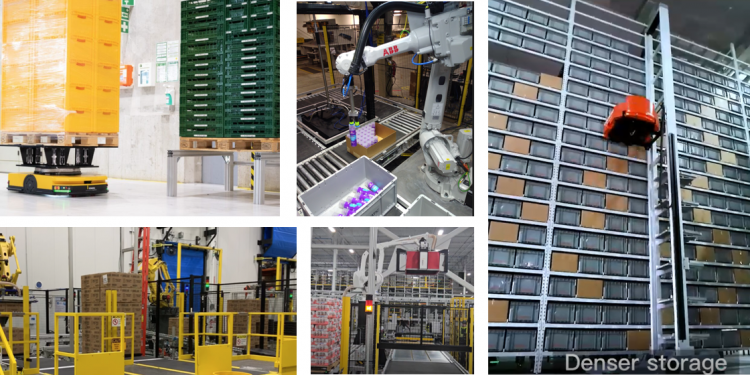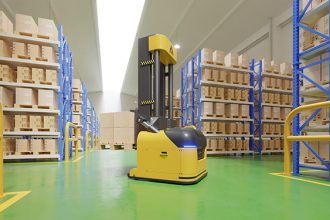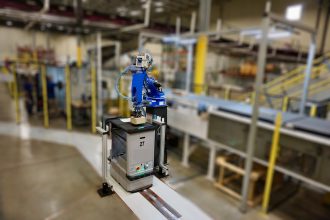Robotics 101

Learn how different robots can operate within your facility to enhance productivity.
Robotics are taking on an increasingly larger role in the warehousing environment, but that hasn’t always been the case. Traditional fixed robots–long a fixture in the automotive industry—haven’t had as much application for warehousing. Still, they do have a presence. It’s mobile robotics, however, that are truly transforming operations.
In essence, robots serve to take on the dirty, heavy, and dull jobs that human workers would rather avoid. In an era with a tough labor shortage, this can be a huge help when recruiting and retaining workers. From palletizing to picking and variations of each, robots can step in and do the repetitive and strenuous tasks people would rather skip. They come in versions of fixed and mobile.
Traditional articulated arms, which can range from two-jointed robots on up to those with 10, are generally used in palletizing applications. They save team members from lifting heavy loads and can accomplish moving full stacks of pallets much more efficiently than would a human employee. They might also pick up a box to move it from one spot to another, using a gripper attachment to do so. There are also gantries, a version of a fixed robot, that have some limited applications in warehousing. They’ve long been popular in automotive manufacturing to move tires/stacks of tires from one location to another, and when warehouses involve tire storage, they are a useful tool.
As robots have evolved to include mobile units, they’re finding their way onto warehousing floors more frequently, and have more applications in this environment than have fixed robots. The two basic models are automatic guided vehicles (AGVs), and autonomous mobile robots (AMRs). The main difference in function between the two is that AGVs follow a fixed path, while AMRs—as the name implies—operate independently and can move all over a warehouse floor. Each has its own strengths for applications on the floor.
Today, AGVs and AMRs operate collaboratively with their human counterparts. They might bring a load of cases to a station for picking, for instance. This saves employees from walking all over the facility, making better use of their time and abilities. Or a warehouse might choose to deploy them to move materials from storage bins to sortation systems or integrate them with fixed picking arms. The possibilities are growing as the technology driving the robots becomes ever more sophisticated.
Many facilities worry about the safety of having mobile robots on the floor alongside humans, but today’s models often work with AI-enhanced vision, which allows them to “see” and avoid hazards better than in the past. The longer they operate on a warehousing floor, the better they become. Still, when considering mobile robots, it’s essential to work with a qualified partner to design and implement exactly how the robots will operate and in which scenarios.
Robots are changing the world, and warehousing, to become more efficient and productive.
Source: Matt Bush, KPI Solutions
Learn more about The Robotics Group (TRG): mhi.org/trg
For further articles from the The Robotics Group (TRG):
Order Orchestration Optimization Through Robots
Robotics in Logistics, Part 2 – You’ve Decided to Add Robots—Now What?
Will Robots Change Your Warehouse Culture?
Robots Make Work Easier For Humans
When Flooring Takes Center Stage In Robotics
How To Avoid Potential Pitfalls Of Robotics Ownership
Your Guide To Successful Metrics For Automation Implementation



